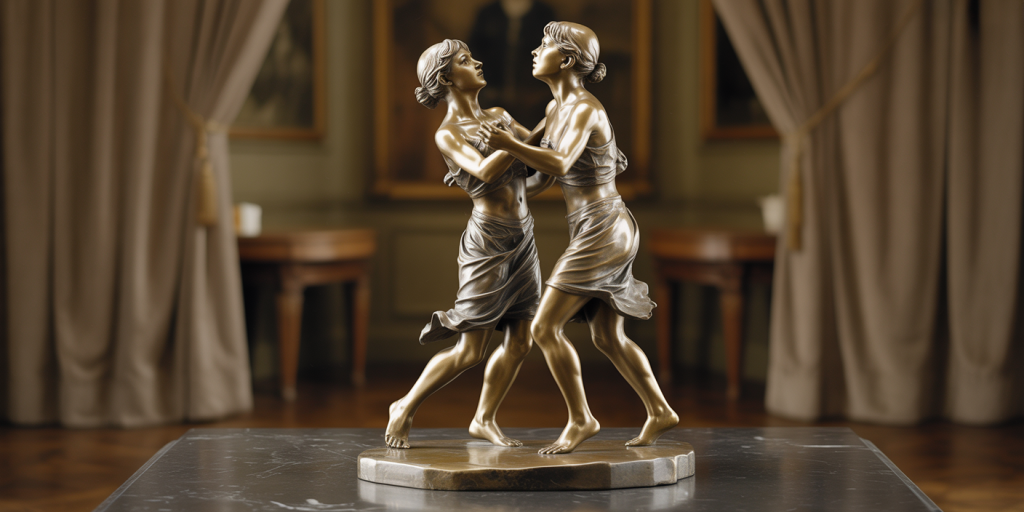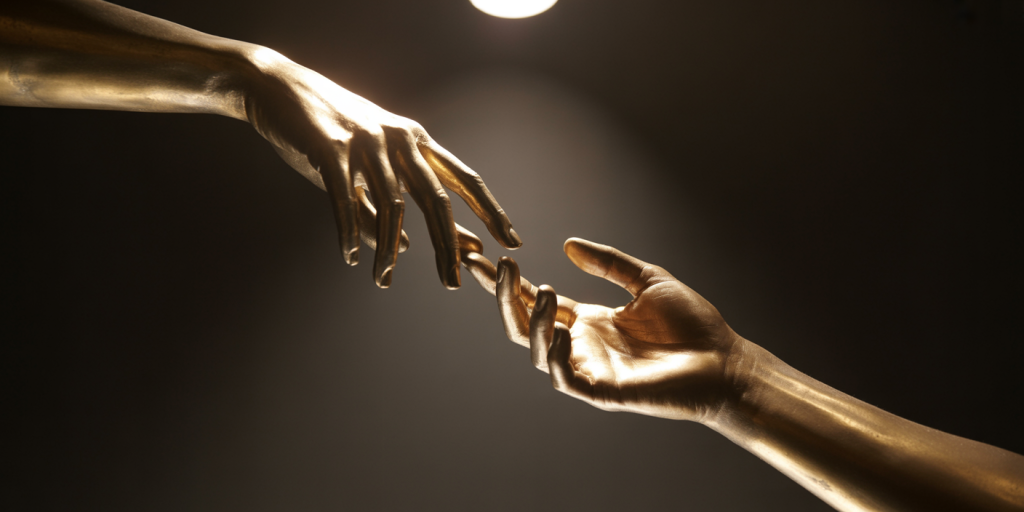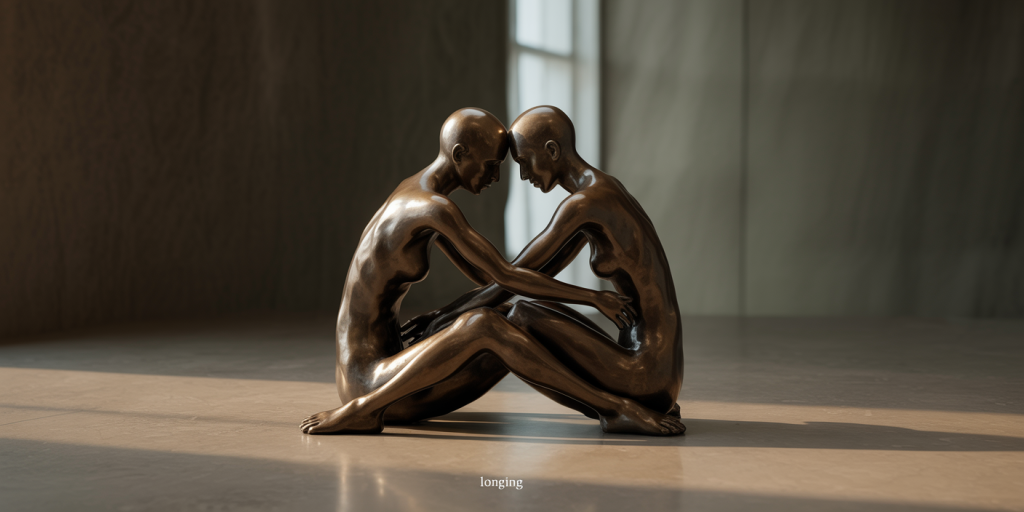In the Flesh of Bronze: Camille Claudel and the Desires We Lost
There are sculptures that do not merely capture form, but longing. Camille Claudel carved not just figures, but confessions—intimate, irretrievable, pulsing with the ache of what could not last. Her bronze bodies do not stand still; they tremble in place, vessels of remembered heat and gestures that echo long after the hands have let go. In her work, desire is not dramatic. It is slow, intimate, and devastatingly human.
To approach Claudel’s sculptures is to enter the still-burning ruins of passion. There is no grand narrative—only gestures frozen at the threshold of surrender, of absence. She sculpts the soul mid-sigh, the fingertips just before touch, the gaze turned inward, toward what was lost. The bronze may be cool, but the emotions it holds are still hot, still breathing. These are not statues. They are remnants of desire, shaped with the fingers of memory and pain.
Summary
- Bronze that Bleeds
- The Flame Between Fingers
- Echoes of Unfinished Touch
- When Passion Crystallizes
- Draped in Absence
- The Weight of Tenderness
- A Sculptor’s Solitude
- Breathing Through Bronze
- The Silence Between Lovers
- Eyes that Remember Skin
- Intimacy Carved in Curves
- Shadows Beneath the Patina
- The Vulnerability of Posture
- The Body Remembering Itself
- When Movement Pauses to Mourn
- Light that Clings to the Flesh
- Sculpting the Ghost of a Caress
- The Longing in the Negative Space
- From Muse to Mourner
- The Memory That Stays Cold
Bronze that Bleeds
Claudel’s sculptures hold a peculiar tension: solid bronze that feels fluid, almost bleeding. The forms are finished, yet they suggest movement, regret, transition. The bronze itself becomes paradoxical—capable of recalling both the warmth of skin and the permanence of what is gone.
In works like The Waltz, the figures swirl, but the air around them is heavy. The metal, darkened with age and emotion, becomes not just material—but message. A bronze that remembers, that bleeds inward.
The Flame Between Fingers
Her hands—both her real ones and those rendered in bronze—speak in whispers. In her sculptures, fingers often stretch toward each other, never quite touching. There is always a flame between them: of desire, of distance, of the things that burned too brightly to last.
This distance is not lack—it is tension. It is the flicker of what was once fire, now sealed in a stillness more painful than silence.

Echoes of Unfinished Touch
Claudel never sculpted simple contact. Her figures often pull back just before the embrace completes, as if haunted by the risk of vulnerability. That pause before closeness is the place she inhabits.
The touch she sculpts is psychological. It is unfinished not by accident, but by design—to evoke all that was almost, all that remains only in muscle memory.
When Passion Crystallizes
In her works, passion is not chaos—it is crystal. Clear, sharp, dangerous. It holds its form with impossible precision, trapping movement in its most revealing state. Her lovers are not just in motion—they are at the edge of revelation.
Like amber encasing breath, Claudel’s passion is suspended, preserved in a moment that feels both eternal and instantly perishable.
Draped in Absence
Fabric in Claudel’s sculptures does not conceal—it accentuates. The folds wrap around bodies as if memory itself were trying to hold on. But there is always a sense of falling, of the drape slipping, of something no longer there.
Absence is her true material. Even when a figure is whole, we feel the shadow of what they’ve lost or what they once held.
The Weight of Tenderness
Her figures bend—not with pain, but with care. Their bodies lean, kneel, surrender. There is no violence in their poses, only the solemn weight of tenderness. To feel this softness in bronze is disarming.
Claudel reminds us that love, when remembered, is heavier than grief. And tenderness, when abandoned, leaves a bruise that never cools.
A Sculptor’s Solitude
Camille Claudel’s art is inseparable from her solitude. Her later years, marked by confinement and silence, echo in the stillness of her figures. They do not weep. They do not scream. But they are alone—even when sculpted in pairs.
Her solitude was not chosen, but her art transformed it. She sculpted not isolation, but the soul reaching through it—fragile, burning, and unfinished.

Breathing Through Bronze
The breath in Claudel’s figures is palpable. Even in their stillness, one feels a chest expanding, a shoulder rising, a head tilting toward a whisper. The metal captures not just form, but breath.
Her mastery lies in this: turning breathless bronze into lungs that remember how it felt to hold someone, and to be held.
The Silence Between Lovers
The space between her lovers is as sculptural as the bodies themselves. That space is filled with silence—not the absence of sound, but the residue of what was once said with skin, eyes, breath.
This silence speaks louder than touch. It tells of desires denied, of memories too raw to hold but too vital to release.
Eyes that Remember Skin
Even when her figures lack detailed facial features, their eyes remain powerful. They do not gaze outward; they look inward—or toward someone no longer there. They carry not sight, but memory.
These are not the eyes of observers—they are the eyes of the remembered, the eyes that once knew skin intimately.
Intimacy Carved in Curves
Claudel did not sculpt bodies as anatomy. She sculpted them as memory: soft, curved, curling in on themselves like leaves in late autumn. Every contour speaks of closeness.
These curves are not idealized—they are emotive. They are bodies shaped by love, touched by time, and abandoned by presence.
Shadows Beneath the Patina
The patina of bronze carries time in its sheen. In Claudel’s work, it darkens in folds, deepens in hollows. These shadows are not flaws; they are soul. They collect the things unsaid.
Every shadow is a pause. A sigh held too long. A name almost spoken.
The Vulnerability of Posture
Her figures do not pose; they offer themselves. Knees bent, necks exposed, backs curved—they surrender to the moment. Their vulnerability is not theatrical—it is sacred.
In their postures, we read an emotional script: of trust, of pleading, of letting go. Of bodies that once reached for something more.
The Body Remembering Itself
Claudel’s bodies feel as though they remember. They are not neutral—they carry a story in every tendon. A story of having been touched, of having felt. Of being changed.
These sculptures remember not what was done, but what was felt. They are bodies that echo with experience.
When Movement Pauses to Mourn
There is often a halt in her figures—a moment just before collapse or kiss or flight. This pause feels sacred, heavy with mourning. The movement is not arrested—it is reconsidered.
This mourning is not death—it is the grief of memory. The loss of what was once living in the fingertips, now sealed in metal.

Light that Clings to the Flesh
In Claudel’s bronze, light behaves like memory: it clings. It does not simply illuminate—it caresses. It slips into the curves, slides over the collarbones, pauses at the mouth.
Her surfaces are not smooth for vanity—they are smooth for touch. Light remembers every place a hand might have wandered.
Sculpting the Ghost of a Caress
Many of her works feel like ghosts of affection. They are not love itself, but its echo. Not touch, but its absence.
Claudel sculpted not the moment of passion—but the moment after. When the skin is cold, but the soul is still on fire.
The Longing in the Negative Space
Her genius lives in the negative space—in the voids between limbs, in the air above a bowed head. These spaces are not empty—they hold everything we cannot hold.
Desire lives here. Not in what is shaped, but in what escapes. In the breath we can’t catch, the lover we can’t reach.
From Muse to Mourner
Camille Claudel was once called a muse. But her sculptures reject that passive role. She sculpted not as inspiration, but as witness—as mourner of her own silences, her own forgotten fire.
Through bronze, she reclaimed authorship. She became not muse, but mirror. And in that mirror, she offered the truth of desire lost.
The Memory That Stays Cold
Bronze stays cool. And yet, Claudel made it burn. Her work is the paradox of cold memory and hot feeling. A sculpture that does not age, but always remembers.
In this temperature lies truth: that some desires never fade. They settle into the metal. They become the sculpture.
FAQ – Frequently Asked Questions
Who was Camille Claudel?
Camille Claudel (1864–1943) was a French sculptor and artist, known for her emotionally charged bronze and marble sculptures. She was a student, collaborator, and lover of Auguste Rodin, but her style evolved into something deeply personal and distinct.
What themes define her work?
Her works often explore desire, abandonment, intimacy, the female body, and the emotional weight of memory. Many pieces reflect the pain of lost love and solitude.
What are her most famous sculptures?
Notable works include The Waltz, The Age of Maturity, Clotho, and Sakuntala. Each reflects a unique psychological depth, blending movement with emotional gravity.
Why was she institutionalized?
After years of artistic isolation and emotional suffering, Claudel was committed to a psychiatric hospital by her family, where she remained for 30 years until her death. Her artistic legacy was largely forgotten for decades.
What is her legacy today?
Today, Camille Claudel is celebrated as one of the most powerful sculptors of her time. Her story has inspired books, films, and major retrospectives, finally giving voice to the silence her sculptures so deeply express.
Final Reflections – The Bronze that Guards the Burnt
Camille Claudel sculpted not what is seen, but what is remembered. Her bronze does not boast—it mourns. Her curves do not seduce—they speak.
In her work lives a truth often too fragile for words: that desire, once felt, never truly disappears. It lingers in the body, in the breath, in the space between gestures. It hardens into bronze not to be preserved, but to be felt again and again—with each gaze, each tear, each sigh that escapes without reason.
Claudel gave form to the desires we lost. And in doing so, she made them eternal.
